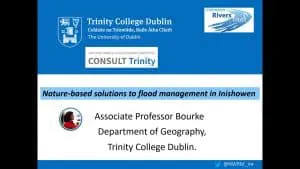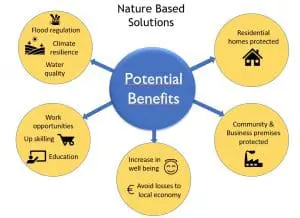July 23rd 2020 – Members of the Clonmany community came together in the Community Centre on Thursday night July 23rd to discuss nature based solutions (NBS) for flood management with flood experts Prof Mary Bourke, Trinity College and Dr. Paul Quinn, University of Newcastle. Prof. Bourke linked in via Zoom to deliver a presentation that covered the whys, whats and hows of using NBS. Her presentation can be viewed on this link https://youtu.be/NoERdpWhXbg

Presentation by Prof Bourke
During her presentation Prof. Bourke discussed reasons why nature based solutions are viable options for Clonmany. NBSs are cheaper to install and more flexible in the face of a changing climate and the increased likelihood of flooding for the future. No flood relief scheme is planned for Clonmany and this makes a community based solution even more important. She emphasised, “What we are looking at is increasing our resilience to flooding by looking at a combination of Nature Based Solutions and property flood resilience as part of an effective approach to future flooding. We are looking to slow the flow over land, keeping the water in the landscape a little bit longer. We are not looking to flood farmland.”
Prof Bourke went onto discuss how NBS measures achieve this, through small interventions, such as earth and wood bunds and leaky dams. She addressed the key questions of does it work and how much does it cost? She gave the example of the Frome catchment in Stroud, UK where the community came together to find a solution to the frequent flooding in their town and now 500+ interventions have
 reduced the frequency and impact of floods in the area despite the increase in the number and intensity of these floods.
reduced the frequency and impact of floods in the area despite the increase in the number and intensity of these floods.
The presentation went on to discuss the scoping study funded by the OPW and carried out by Prof. Bourke and her team looking at the suitability of the land in Inishowen, including a closer look at the Ballyhallan River. Researching land cover and slope, her team concluded that the area has widespread opportunities for these measures but that the approach should be at a catchment scale.
Wide ranging discussion
Following the presentation there was a Q&A with Mary Bourke and Paul Quinn and a frank and open discussion on the flooding issues and impacts faced by the community. Dr. Quinn answered many questions on dredging, how leaky dams work and understanding the needs of the community. Overgrowing vegetation, blocked drains and streams and eroding banks are all existing problems. The wide range of views expressed led to an excellent discussion on the possibility of a co-ordinated approach such as that taken in Stroud.
IRT Project Officer Trish Murphy summarised, “Coming together as a community and combining our knowledge and experience of the issues with the scientific knowledge can bring about a sea change in how we approach this problem. Working in isolation to sort a problem section of the river can lead to problems for others up or down stream. We can approach this problem in a co-design and co-production capacity. The Inishowen Rivers Trust are willing to co-ordinate efforts to secure funding and consultants to design nature based solutions in collaboration with the community. We can then train the local community on how to implement these, building knowledge on how the rivers work and how we can adapt to make them more resilient.”
Problem areas identified
Every participant at the event had the opportunity to highlight a map of the rivers to identify flood prone areas and where the floods may originate. Several areas were identified: Clonmany-Meendoran area; junction of Clonmany and Cloontagh river; junction of Clonmany & Clehagh rivers; Shivnagh river at the confluence of several tributories; Adderville & Effishmore tributories; Straid river above Butler’s Glen; confluence of Ballyhallan and Garryduff rivers in Clonmany village; stream behind Riverside Park; Binnion area. This feedback illustrates how widespread the issue of flooding has become for Clonmany. Nature based solutions are particularly suited to tackling a diffuse series of problems as the interventions are small and flexible.
Outcome
By the end of the evening, the community agreed that it was worth a try to move forward and agreed to support the efforts of the IRT in establishing a nature based project. In the meantime if anyone in the community wishes to provide further feedback or has questions please Contact us. You can also keep up to date with our work through FB/InishowenRiversTrust.


